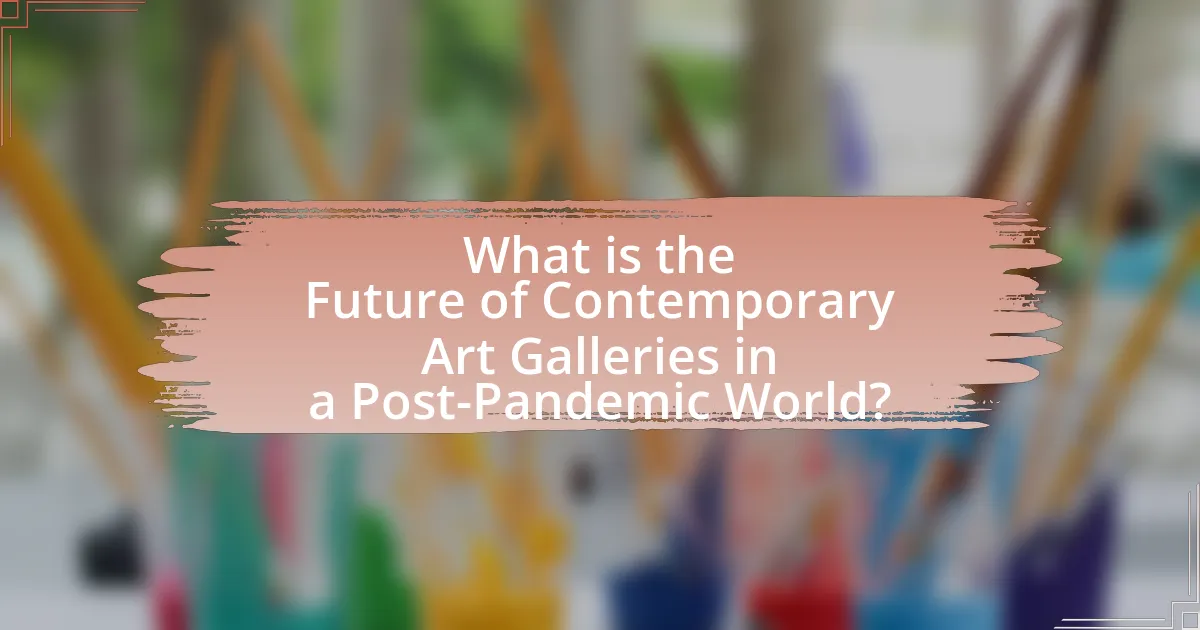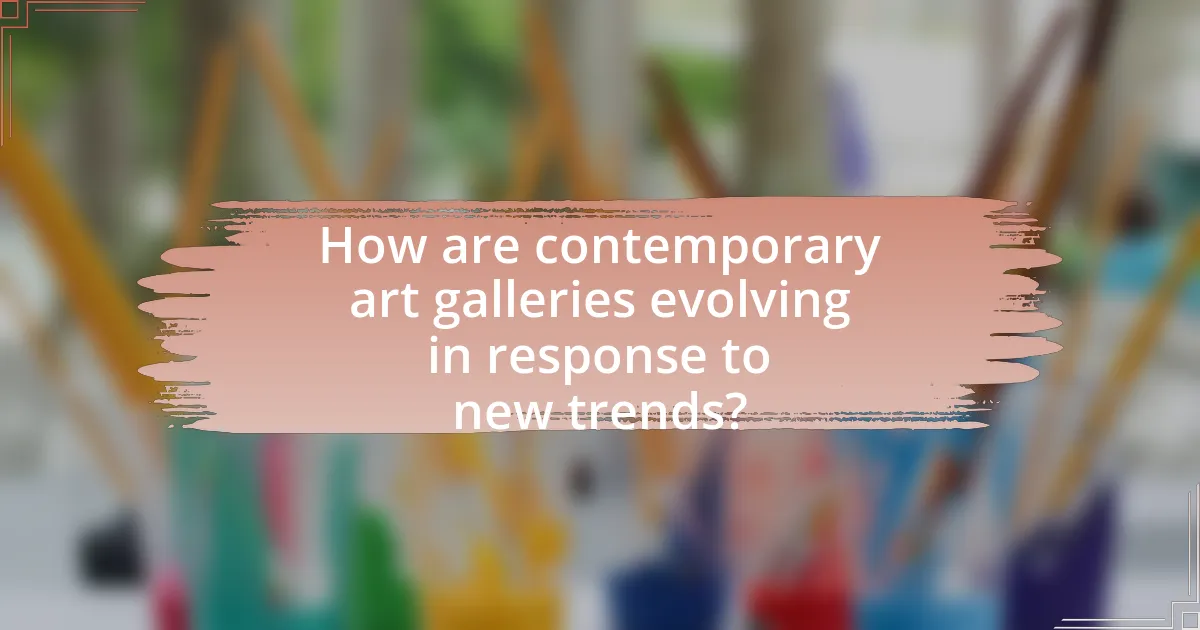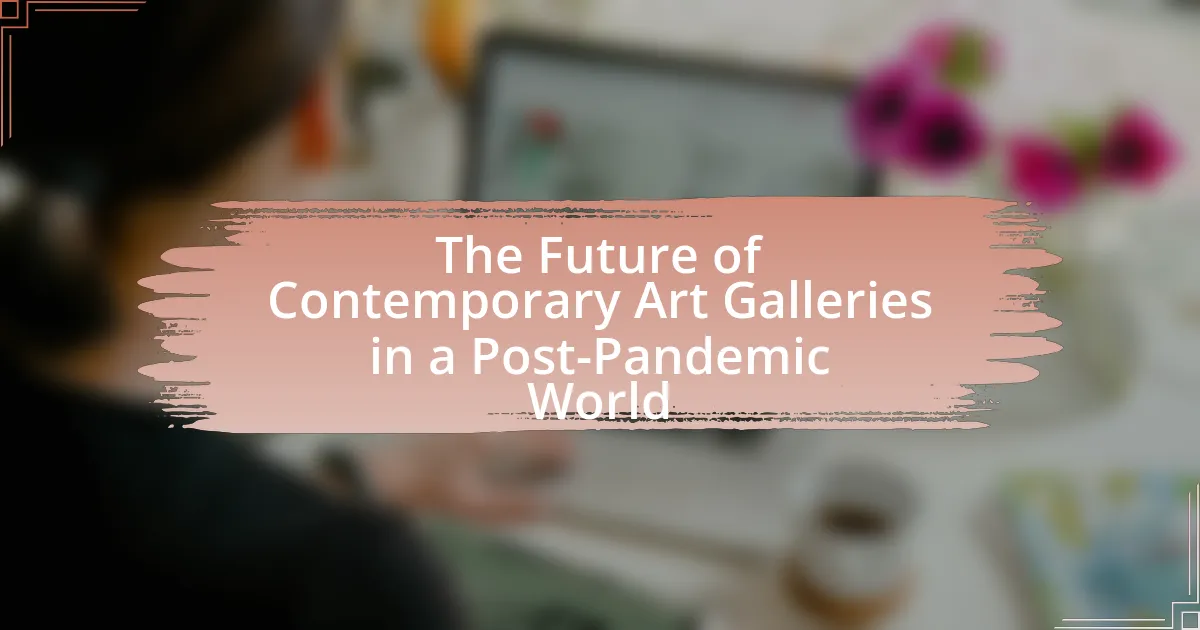The article examines the future of contemporary art galleries in a post-pandemic world, highlighting the shift towards a hybrid model that integrates physical exhibitions with digital experiences. It discusses how the pandemic has accelerated the adoption of online platforms, leading to increased online sales and a redefined role for galleries as community hubs. Key changes in visitor behavior, operational adaptations, and the challenges galleries face, such as reduced foot traffic and financial instability, are also addressed. Additionally, the article explores the implications of digital transformation, the importance of inclusivity and diversity in programming, and strategies for enhancing community engagement and sustainability in gallery operations.

What is the Future of Contemporary Art Galleries in a Post-Pandemic World?
The future of contemporary art galleries in a post-pandemic world is likely to involve a hybrid model that combines physical exhibitions with digital experiences. This shift is driven by the increased acceptance of online platforms for art viewing and sales, as evidenced by a 2021 report from Art Basel and UBS, which noted that online sales in the art market reached $12.4 billion, a significant increase from previous years. Galleries will need to adapt by enhancing their digital presence, utilizing virtual reality, and engaging audiences through social media to remain relevant and accessible. Additionally, the focus on community engagement and local artists is expected to grow, as galleries seek to foster connections and support within their communities in response to the pandemic’s impact on social interactions.
How has the pandemic reshaped the landscape of contemporary art galleries?
The pandemic has significantly reshaped the landscape of contemporary art galleries by accelerating the adoption of digital platforms and altering visitor engagement strategies. As physical spaces faced restrictions, many galleries transitioned to virtual exhibitions and online sales, leading to a broader audience reach; for instance, a survey by Art Basel and UBS in 2021 indicated that 70% of galleries reported increased online sales during the pandemic. Additionally, galleries have redefined their roles as community hubs, focusing on inclusivity and accessibility, which has been essential for maintaining relevance in a changing cultural environment.
What are the key changes in visitor behavior post-pandemic?
Key changes in visitor behavior post-pandemic include a significant increase in online engagement and a preference for smaller, more intimate gatherings. Visitors now prioritize health and safety, leading to a rise in virtual tours and online exhibitions, which saw a 70% increase in participation during the pandemic. Additionally, there is a growing demand for outdoor spaces and flexible visiting hours, as people seek to avoid crowded environments. This shift is supported by surveys indicating that 60% of art enthusiasts prefer visiting galleries during off-peak times to ensure a more comfortable experience.
How have art galleries adapted their operations during the pandemic?
Art galleries have adapted their operations during the pandemic by implementing virtual exhibitions and online sales platforms. This shift allowed galleries to reach a broader audience while physical attendance was restricted. For instance, many galleries utilized social media and digital marketing strategies to promote their online events, resulting in increased engagement and sales. According to a survey by Art Basel and UBS, 70% of galleries reported that online sales became a significant part of their revenue during the pandemic, highlighting the effectiveness of these adaptations.
What challenges do contemporary art galleries face in the post-pandemic era?
Contemporary art galleries face significant challenges in the post-pandemic era, primarily including reduced foot traffic, financial instability, and the need for digital transformation. The decline in physical attendance is evidenced by a 2021 report from the Art Basel and UBS Global Art Market Report, which noted a 36% drop in gallery sales compared to pre-pandemic levels. Financial instability arises from increased operational costs and decreased revenue, forcing galleries to adapt their business models. Additionally, the necessity for digital transformation has become critical, as galleries must enhance their online presence and virtual engagement strategies to reach broader audiences, a shift highlighted by the 2022 McKinsey report on the art market, which emphasized the importance of digital platforms for future growth.
How has funding and financial support changed for galleries?
Funding and financial support for galleries has shifted significantly due to the impact of the COVID-19 pandemic. Many galleries have experienced a decline in traditional revenue streams, such as ticket sales and art sales, leading to increased reliance on alternative funding sources. For instance, a report by the National Endowment for the Arts indicated that 63% of arts organizations reported a decrease in revenue during the pandemic, prompting galleries to seek grants, crowdfunding, and corporate sponsorships to sustain operations. Additionally, government relief programs, such as the Paycheck Protection Program in the United States, provided temporary financial assistance, allowing galleries to retain staff and cover operational costs. This transition reflects a broader trend towards diversifying funding strategies to ensure long-term sustainability in a changing economic landscape.
What are the implications of digital transformation for galleries?
Digital transformation significantly impacts galleries by enhancing their operational efficiency and expanding audience reach. Galleries can leverage digital tools for virtual exhibitions, allowing them to showcase artworks to a global audience, which was particularly crucial during the COVID-19 pandemic when physical attendance was limited. According to a report by Art Basel and UBS, online sales in the art market reached $12.4 billion in 2021, illustrating the growing importance of digital platforms for galleries to generate revenue and engage with collectors. Furthermore, digital transformation facilitates data analytics, enabling galleries to understand visitor preferences and tailor their offerings accordingly, thus improving visitor experience and engagement.

How are contemporary art galleries evolving in response to new trends?
Contemporary art galleries are evolving by integrating digital technologies and enhancing community engagement to adapt to new trends. The rise of virtual exhibitions and online sales platforms has allowed galleries to reach broader audiences, as evidenced by a 2021 report from Art Basel and UBS, which noted a 50% increase in online sales in the art market. Additionally, galleries are focusing on inclusivity and diversity in their programming, reflecting societal shifts and the demand for representation, which has been highlighted by initiatives like the “Diversity in Arts Leadership” program. These adaptations demonstrate how contemporary art galleries are responding to changing consumer behaviors and cultural expectations in a post-pandemic world.
What role does technology play in the future of art galleries?
Technology plays a transformative role in the future of art galleries by enhancing visitor engagement and expanding accessibility. Virtual reality (VR) and augmented reality (AR) allow galleries to create immersive experiences, enabling visitors to interact with art in innovative ways. For instance, the use of VR can transport viewers to different environments or historical contexts related to the artwork, while AR can overlay digital information onto physical pieces, enriching the viewing experience.
Moreover, online platforms and digital exhibitions have become essential, especially post-pandemic, as they allow galleries to reach a global audience, breaking geographical barriers. According to a report by Art Basel and UBS, 70% of galleries increased their online presence during the pandemic, indicating a shift towards digital engagement. This trend not only democratizes access to art but also provides galleries with valuable data on visitor preferences and behaviors, enabling them to tailor experiences more effectively.
In summary, technology is pivotal in redefining how art galleries operate, engage with audiences, and adapt to changing circumstances, ensuring their relevance in a rapidly evolving cultural landscape.
How are virtual exhibitions changing the way art is experienced?
Virtual exhibitions are transforming the way art is experienced by making it more accessible to a global audience. Unlike traditional galleries, which often limit attendance to those who can physically visit, virtual exhibitions allow anyone with internet access to view artworks from anywhere in the world. This shift has been accelerated by the COVID-19 pandemic, which forced many galleries to adopt digital platforms. According to a report by Art Basel and UBS, 70% of galleries increased their online presence during the pandemic, highlighting a significant trend towards digital engagement. Furthermore, virtual exhibitions often incorporate interactive elements, such as 3D walkthroughs and augmented reality features, enhancing viewer engagement and providing a more immersive experience. This evolution in art presentation not only democratizes access but also encourages innovative ways of experiencing and interacting with art.
What are the benefits of integrating augmented reality in galleries?
Integrating augmented reality (AR) in galleries enhances visitor engagement and enriches the overall art experience. AR allows visitors to interact with artworks in innovative ways, such as viewing additional information, animations, or 3D models that complement the physical pieces. This technology can increase visitor retention and satisfaction, as evidenced by a study from the University of Southern California, which found that AR experiences can boost visitor engagement by up to 30%. Furthermore, AR can provide accessibility features, making art more inclusive for individuals with disabilities, thereby broadening the audience base for galleries.
How are galleries addressing inclusivity and diversity in their programming?
Galleries are addressing inclusivity and diversity in their programming by actively curating exhibitions that feature underrepresented artists and communities. This approach includes showcasing works from diverse cultural backgrounds, gender identities, and socioeconomic statuses, thereby broadening the narrative within contemporary art. For instance, a report by the National Endowment for the Arts highlights that galleries are increasingly collaborating with local organizations to engage marginalized groups, ensuring that their voices are represented in the art world. Additionally, many galleries are implementing educational programs aimed at fostering dialogue around diversity, which further supports their commitment to inclusivity.
What initiatives are being taken to support underrepresented artists?
Various initiatives are being implemented to support underrepresented artists, including grants, mentorship programs, and dedicated exhibition spaces. For example, organizations like the Joan Mitchell Foundation provide financial support and resources specifically aimed at artists of color and those from marginalized communities. Additionally, galleries are increasingly hosting exhibitions that focus on underrepresented artists, creating visibility and opportunities for these creators. Programs such as the Art for Justice Fund also aim to empower artists who address social justice issues, further enhancing the representation of diverse voices in the art world.
How can galleries create more accessible spaces for diverse audiences?
Galleries can create more accessible spaces for diverse audiences by implementing universal design principles, which ensure that all individuals, regardless of ability, can engage with the art. This includes physical accessibility features such as ramps, elevators, and clear signage, as well as sensory-friendly environments that accommodate individuals with sensory sensitivities.
Research indicates that 1 in 4 adults in the U.S. experience a disability, highlighting the importance of inclusivity in public spaces (CDC, 2021). Additionally, offering programs in multiple languages and providing materials in various formats can further enhance accessibility for diverse cultural backgrounds. By actively seeking feedback from underrepresented communities, galleries can tailor their offerings to better meet the needs of all visitors, fostering a more inclusive atmosphere.

What strategies can contemporary art galleries implement for future success?
Contemporary art galleries can implement digital engagement strategies for future success. By enhancing their online presence through virtual exhibitions, social media marketing, and e-commerce platforms, galleries can reach a broader audience and adapt to changing consumer behaviors. For instance, a report by Art Basel and UBS in 2021 indicated that online sales in the art market reached $12.4 billion, highlighting the importance of digital channels. Additionally, galleries can foster community involvement by hosting interactive events and workshops, which can increase local engagement and support. These strategies not only cater to the evolving landscape of art consumption but also ensure galleries remain relevant and financially viable in a post-pandemic world.
How can galleries enhance community engagement post-pandemic?
Galleries can enhance community engagement post-pandemic by implementing interactive programs and events that foster participation. For instance, hosting workshops, artist talks, and community art projects encourages local involvement and collaboration. Research indicates that community-driven initiatives can increase attendance and strengthen relationships between galleries and their audiences, as seen in the success of programs like “Art in the Park,” which attracted diverse community members and promoted inclusivity. By prioritizing accessibility and creating spaces for dialogue, galleries can effectively engage their communities in meaningful ways.
What are effective ways to collaborate with local artists and organizations?
Effective ways to collaborate with local artists and organizations include establishing partnerships for joint exhibitions, hosting workshops, and creating community art projects. These collaborations can enhance visibility for both artists and galleries, fostering a sense of community engagement. For instance, galleries can organize pop-up events featuring local artists, which not only showcases their work but also attracts diverse audiences. Additionally, involving local organizations in these initiatives can provide resources and support, further enriching the collaborative experience. Research indicates that community-based art initiatives can increase participation and support for local artists, demonstrating the mutual benefits of such collaborations.
How can galleries leverage social media to reach wider audiences?
Galleries can leverage social media by creating engaging content that showcases their exhibitions and artists, thereby attracting a broader audience. Utilizing platforms like Instagram and Facebook allows galleries to share high-quality images, videos, and live streams of events, which can increase visibility and engagement. According to a 2021 survey by Art Basel and UBS, 70% of collectors reported discovering new artists through social media, highlighting its effectiveness in reaching potential audiences. Additionally, galleries can use targeted advertising to reach specific demographics, further expanding their reach.
What best practices should galleries adopt for sustainable operations?
Galleries should adopt energy-efficient practices, such as using LED lighting and optimizing climate control systems, to reduce their carbon footprint. Implementing a waste management strategy that includes recycling and composting can further minimize environmental impact. Additionally, galleries can prioritize sourcing materials from sustainable suppliers and utilizing digital platforms for exhibitions to decrease physical resource consumption. Research indicates that energy-efficient lighting can reduce energy use by up to 75%, demonstrating the effectiveness of these practices in promoting sustainability.
How can galleries implement eco-friendly practices in their exhibitions?
Galleries can implement eco-friendly practices in their exhibitions by utilizing sustainable materials, reducing energy consumption, and promoting digital engagement. For instance, galleries can use recycled or biodegradable materials for displays and signage, which minimizes waste. Additionally, galleries can adopt energy-efficient lighting and climate control systems to lower their carbon footprint. Research indicates that energy-efficient practices can reduce operational costs by up to 30%, making them both environmentally and economically beneficial. Furthermore, galleries can enhance visitor experiences through virtual exhibitions, which decrease the need for physical resources and travel, aligning with eco-conscious values.
What role does audience feedback play in shaping gallery strategies?
Audience feedback plays a crucial role in shaping gallery strategies by providing insights into visitor preferences and engagement levels. This feedback allows galleries to tailor their exhibitions, programming, and marketing efforts to better align with audience interests, thereby enhancing visitor experience and attendance. For instance, a study by the National Endowment for the Arts found that galleries that actively solicit and incorporate audience feedback see a 30% increase in repeat visitors. By analyzing visitor comments and survey data, galleries can identify successful elements and areas needing improvement, ultimately leading to more effective and responsive strategies in a post-pandemic context.
What practical steps can galleries take to thrive in the new normal?
Galleries can thrive in the new normal by adopting a hybrid model that combines in-person and virtual experiences. This approach allows galleries to reach a broader audience, as evidenced by a report from Artsy, which found that online art sales surged by 50% in 2020, indicating a significant shift in consumer behavior. Additionally, galleries should enhance their digital presence through social media marketing and virtual exhibitions, which can attract new collectors and engage existing patrons. Implementing flexible pricing strategies and offering exclusive online content can also help galleries adapt to changing market demands. By focusing on community engagement and collaboration with local artists, galleries can foster a supportive environment that encourages attendance and participation, ultimately driving sales and visibility in a post-pandemic landscape.


